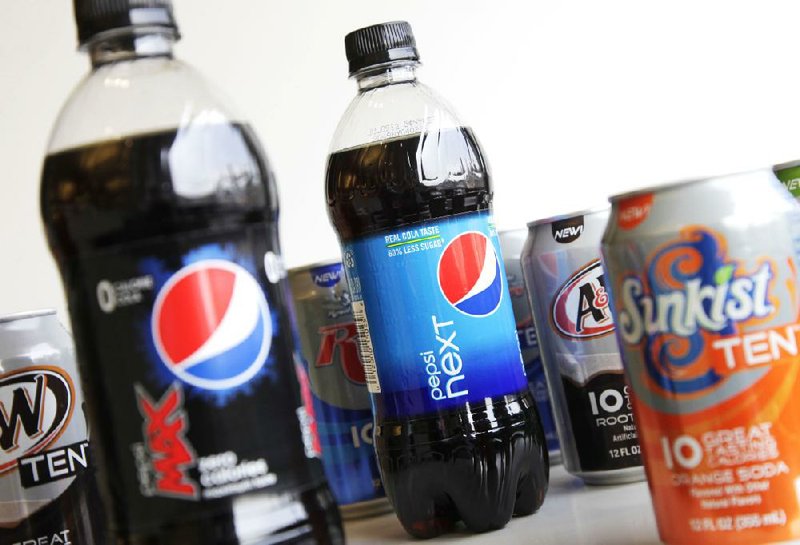NEW YORK — Coke and Pepsi are chasing after the sweet spot: a soda with no calories, no artificial sweeteners and no funny aftertaste.
The world’s top soft-drink companies hope the elusive trifecta will silence health concerns about soda and reverse the decline in carbonated-drink consumption. But such a formula could be years away.
That’s because the ingredient that makes soda taste good is also what packs on the pounds: high-fructose corn syrup.
Artificial sweeteners like aspartame that are used in diet drinks don’t have any calories but are seen as processed and fake. Natural sweeteners that come from plants present the most promising alternative, but companies haven’t yet figured out how to mask the metallic aftertaste.
Despite the complexities, soft-drink makers push on in their search.
“I can’t say when it will be here, but it’s in the reasonable future,” said Al Carey, who heads the beverage unit for the Americas at PepsiCo Inc., the world’s No. 2 soda maker.
There’s good reason that soft-drink makers are so eager to tweak their formulas. Once a beloved American treat, sodas are now being blamed for the nation’s bulging waistlines — two-thirds of the country’s adults are overweight or obese, according to the Centers for Disease Control and Prevention. That, coupled with the growing variety of flavored waters and sports drinks, has sent percapita soda consumption down 17 percent to about 1.3 cans a day since its peak in 1998, according to Beverage Digest, an industry tracker.
In New York City, a ban on the sale of sugary drinks bigger than 16 ounces in restaurants, theaters and stadiums could take effect as early as March. The mayor of Cambridge, Mass., proposed a similar ban last month. And in Richmond, Calif., voters will decide in November whether to pass the nation’s first penny-per-ounce tax on soda and other sugary drinks such as fruit juices and teas.
All the negative publicity has some once-faithful soda drinkers cutting back.
High-fructose corn syrup, the cheap sweetener that’s used in most sodas, has the same nutritional value and taste of sugar. A can of regular soda typically has about 40 grams of high-fructose corn syrup and 140 calories. By comparison, the same amount of apple juice has about 38 grams of sugar and 165 calories, but companies can tout the vitamins and other nutrients juice provides.
Aspartame, the artificial sweetener commonly used in drinks such as Diet Coke and Diet Pepsi, doesn’t have any calories. But some drinkers worry about the fact that such sweeteners don’t naturally occur in nature. Public perception has been colored by past studies that have suggested it caused cancer and brain tumors in rats even though the American Cancer Society says there’s no evidence showing it has any link with an increased risk for cancer in adults.
The concerns have led soft-drink companies to search for natural, zero-calorie sweeteners, including stevia, which is derived from a South American shrub. Natural sweeteners have neither the calories of sugar nor the negative associations of artificial sweeteners. The trick, however, is figuring out how to make them taste good in colas.
“Every sweetener has its own notes that need to be mixed with other flavors,” said Mehmood Khan, chief science officer for PepsiCo. “It’s a bit like an orchestra playing music, as opposed to one instrument.”
So far, stevia is the natural sweetener that has gotten the most attention and is already used in Coca-Cola and Pepsi-Co products, including orange juice and bottled teas. But it’s proving more difficult to hide the aftertaste in colas.
Soft-drink makers are testing different extracts from the stevia plant that they hope will be easier to blend. They’re also scouring the world for other naturally occurring sweeteners, such as one called mogroside that is extracted from monk fruit and a derivative of a berry called miracle fruit.
Coca-Cola, based in Atlanta, says it’s currently testing additional drinks that use stevia and other natural sweeteners but declined to give details. The tests are part of the ongoing “homeuse tests” the company conducts, in which consumers may be given a six-pack of a new product to try over the course of a week.
“Some of the very exciting [sweeteners] we’re playing with are really small in terms of production and planting, and they need to be nurtured,” said Katie Bayne, president of Coca-Cola’s North American soda business.
Dr Pepper Snapple Group, the nation’s third-largest soda maker, also is searching for the right combination.
At a beverage industry conference earlier this year, Dr Pepper Chief Financial Officer Marty Ellen said he thinks a “sweetener breakthrough” is achievable in the next few years.
Re-creating the exact taste of extremely valuable brands such as Coke and Pepsi is a high-stakes game and companies don’t want to rush any drinks to the market. But making a natural cola that doesn’t have any calories isn’t impossible. Smaller companies such as Zevia, based in Culver City, Calif., already make such colas using stevia.
Information for this article was contributed by Jason Keyser of The Associated Press.
Business, Pages 66 on 07/29/2012
